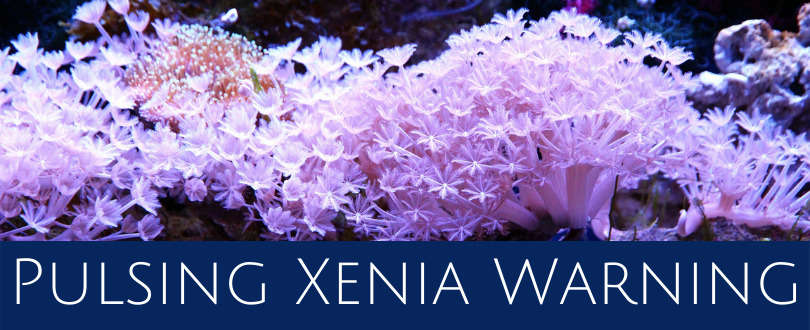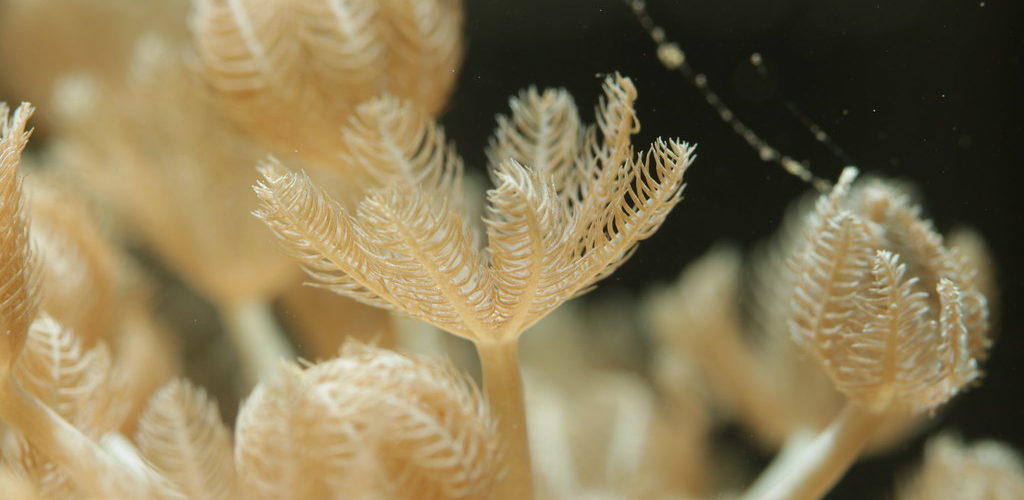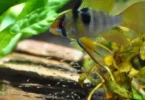Last Updated on November 19, 2022 by Matt
Xenia Coral, or Pulsing Xenia as they are often called, are soft corals in the family Xeniidae. There are numerous different genera of Xenia Coral in this family, and within these genera are a multitude of species but all share similar characteristics. In general when Pulsing Xenia is mentioned or sold, it is coral in the Xenia genus that is being referenced. Although all coral genera in the Xeniidae family are also known as Pulsing Xenia or Xenia Coral as they look very similar.
In this complete Xenia Coral care guide we will give you information on the three main genera of Xeniidae that you will find in the aquarium trade, and how best to care for these amazing corals.
IN THIS ARTICLE
Introducing Pulsing Xenia
Pulsing Xenia is so called because of its appearance and behavior. It is a soft coral, and so doesn’t possess a calcium carbonate exoskeleton. The polyps are reasonably long, with tentacles at the end of the tube-like body. Many polyps can grow out of a single thick stalk attached to rocky substrate. These frond-like feathery polyps earn this coral the name pom pom coral as well. The name Pulsing Xenia comes from the pumping action and behavior that the polyps display. While the exact reason for this pulsing is unknown, it is thought to aid in food capture and waste expulsion.
The coloration of Pulsing Xenia Coral depends on the exact species. Given the wide variety of species, they can be white, tan, grey, or pink. No matter the color, the effect of Xenia Coral in a reef tank is the same!
The following table gives a brief overview and summary of Xenia Coral and the care that they require. Xenia Coral are very common in reef tanks due to their fast growth rate and easy care requirements.
| Xenia Coral Summary | |
| Family | Xeniidae |
| Care level | Easy |
| Temperament | Peaceful |
| Lighting | Moderate |
| Colour | Depends on species. White/gray/pink/tan |
| Diet | Omnivore |
| Water Flow | Moderate – Strong |
| pH levels | 8.1 – 8.4 |
| Water hardness | 8-12 dKH |
| Temperature range | 72-78°F |
| Specific Gravity | 1.023-1.025 |
| Compatibility | Most reef fish |
| Supplements | Calcium, Magnesium, Strontium, Iodine, Trace Elements |
| Tank set up | Saltwater Reef Tank |
Warning About Pulsing Xenia!

While Pulsing Xenia are absolutely stunning and can create brilliant looking tanks, there is a word of warning that needs to be said before you put them in your reef aquarium.
Xenia Coral can quickly take over a tank. In fact some aquarists consider them to be a bit of a pest as they can easily go from beautiful coral to a pain! They absorb nitrate and phosphate in the water column and grow very rapidly. Before you know it, your perfected curated tank that you have spent a lot of time and effort getting perfect can end up dominant completely by Pulsing Xenia.
To prevent this problem you either need to be very on top of cutting back the unwanted growth, or you can do a few things.
Possibly the best way to prevent Xenia Coral from becoming too overpopulated in your tank is to place them on an isolated piece of rockwork away from the main display. They can’t adhere to sandy substrate; they need rock. As such they will only grow to cover the rocky outcrop you place them on. If they are placed on the main rock display they will quickly colonize the whole thing!
Another thing you can do is to surround your Pulsing Xenia with territorially aggressive corals. LPS corals such as Acan coral are known to actively compete for space and will send out specialized long stinging tentacles to ensure they have enough space. Surrounding Xenia Coral with species which display this behaviour can keep its growth in check.
Another thing you can do is have a Xenia species-only tank. A species only tank like this won’t lose any visual impact, and can actually look stunning, especially smaller tanks.
Habitat Requirements
The habitat requirements for Pulsing Xenia are much the same as most other soft corals, and LPS and SPS hard corals as well. As all of these animals are found in tropical coral reef ecosystems, the tank requirements they have are all very similar.
Xenia Coral require a temperature range of 72-78°F, a carbonate hardness of 8-12 dKH, a pH range of 8.1-8.4, and a specific gravity of 1.023-1.025. They will also do well with supplemental trace elements such calcium, magnesium, strontium, and iodine. Like most saltwater reef inhabitants, RODI water is probably best to fill and undertake water changes with.
The tank requirement that is perhaps most important in keeping Pulsing Xenia is the water flow. Moderate to strong water movement is needed for them to remain healthy. Not only does strong water flow allow them to be fully healthy but actually allows you to see their flowing polyps in all their glory!
Lighting can be moderate to low. Most LED lights will be sufficient unless you have a particularly deep or large tank. Fluorescent lighting and metal halide lights are also appropriate. It is thought that Pulsing Xenia directly absorb nutrients such as nitrate and phosphate from the water column, so they can withstand less “clean” conditions than most hard corals. This being said, they do still need a protein skimmer and filter to provide a clean and healthy environment.
They don’t have a minimum tank size, but if you have a smaller tank such as a 10 gallon tank, then having a Xenia Coral only tank will probably be best. For how to set up a tank read our saltwater tank setup guide.
Feeding Xenia Coral
Xenia Coral have a symbiotic relationship with zooxanthellae, the same as all other corals. This zooxanthellae are photosynthetic algae which provide the coral with nutrients from the photosynthesis process in return for a safe place to thrive.
While this provides a good chunk of the nutrients and energy that Xenia Coral needs, they are still animals in their own right, and feed themselves as well. They also absorb nutrients directly from the water column.
The flowing fronds of Pulsing Xenia catch small planktonic animals called zooplankton as well as planktonic algae.
While there will be zooplankton present in your reef tank naturally, you can supplement your coral’s diet by introducing coral food into your reef tank.
Unlike hard corals which need additional feeding, Xenia Coral actually doesn’t require any additional feeding. The zooplankton which is present in your reef tank naturally will be fine along with the nutrients they gain from the water and their zooxanthellae.
While not necessary, you can feed your Xenia if you feel the need. There are two different techniques to feeding corals; spot feeding and blanket feeding.
Spot feeding involves pipetting food items directly over the polyps, using a coral feeder. If you have aquarium LED lighting such as the Current USA Orbit, the wave makers can be programmed into the light control, and have a feeding mode in which the wave makers cease for a time to allow feeding.
Blanket feeding involves simply adding zooplanktonic prey items to the water column, and allowing the current found in the tank to allow the coral to capture it. If you decide to blanket feed, turn off the protein skimmer and canister filter, as these can remove the prey and greatly reduce the amount captured by the coral.
Xenia Compatibility and Placement
Xenia Coral are compatible with any saltwater reef tank setup. There isn’t a minimum tank size that they require; they can be kept in any sized tank, from small nano tanks to much larger tanks. They only require low to moderate lighting so they can be placed at any depth in the tank and will grow very well.
As we have said in the warning, Pulsing Xenia grows very quickly and can easily grow to dominate a tank. As such be careful where you place them if you want a happy community coral reef tank. If you are wanting a Xenia dominant tank, then simply let it do its thing! Xenia only tanks can be quite stunning, and they will also house clownfish the same as sea anemones. If you want to use Xenia in a different way you can utilize them in the sump tank to make a refugium. In this refugium these corals will remove nitrate and phosphate which impact the ability of hard corals to uptake calcium carbonate.
Xenia corals aren’t aggressive and so can be kept with a wide range of fish and invertebrates. However some fish and invertebrates are known to nip at soft corals, and will attack the polyps and the stalks. These fish should be avoided if possible to provide the best possible environment for your Xenia.
Propagating Pulsing Xenia Coral
Propagation of Xenia Coral is very simple, much simpler than you might think. In the main, you will be trying to stop the growth of Xenia species in your tank! Though if you do want to frag Xenia Coral it can be very simple.
As we have said previously, Pulsing Xenia grows very quickly and over a range of substrates. Rather than try and cut and frag Xenia coral directly, the easiest way of getting a cutting is to simply place a piece of loose rock next to your colony and wait for it to grow onto the loose rock. Then viola, you have yourself a Xenia frag.
To attach the frag in the tank, you can use aquarium glue, make a hole in the rock for the frag, or simply attach it with a band and the coral will grow onto the surrounding rock.
Conclusion
Pulsing Xenia are an amazing soft coral which can make a reef tank look fantastic and take it to another level. While care does have to be taken to prevent these corals from overrunning a community tank as they are very fast growing, the result can be well worth it.
Hopefully this Xenia Coral care guide article has been useful and informative. Please let us know how your Xenia is getting along, and as always tell us if you think we have missed any information!
Featured Image Credit: Christoph Gommel (Flickr)







